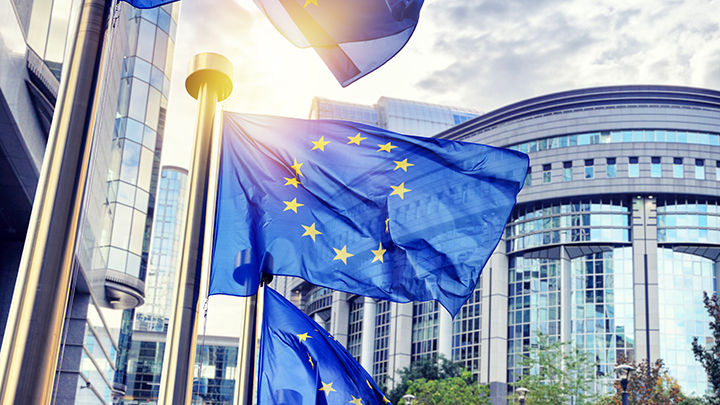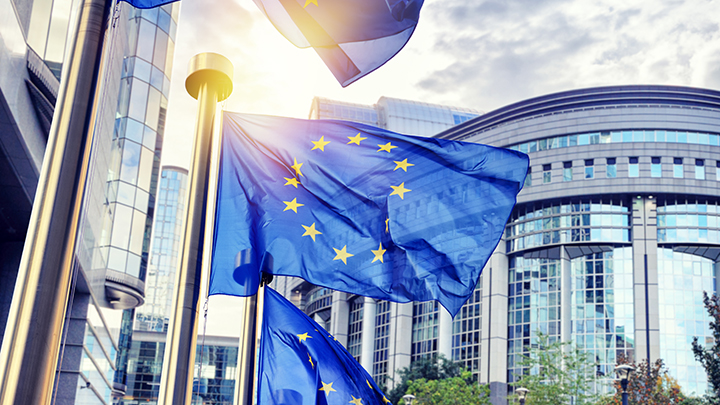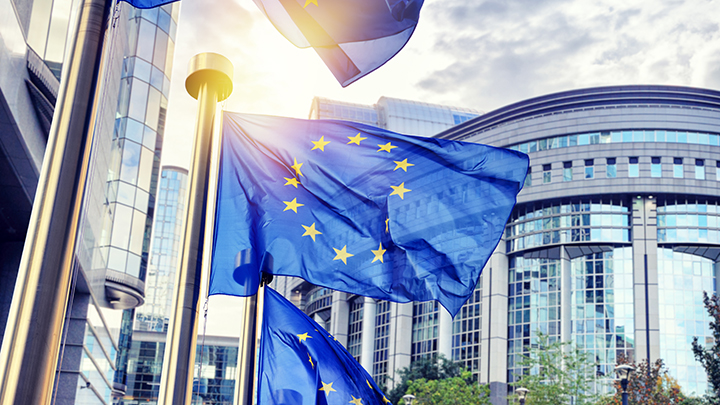The ECB’s March meeting happened against a backdrop of momentous changes on Europe’s fiscal front. Ever since Draghi’s “whatever it takes” speech in 2012, monetary policy in the euro area has been front and centre, with fiscal in the back seat. We are now witnessing a role reversal. The ECB has cut its policy rate by 150 bps since last summer. But with fiscal now stepping up, we think the ECB may be largely done with its rate cuts. Any subsequent moves will be steered by incoming data in a world of increasingly fat tails.
Our Take on the Meeting
As expected, the ECB cut its main policy rate by 25 bps on Thursday, bringing the base rate to 2.5%. Alongside the policy decision, ECB staff updated their euro area projections that point to weaker growth and higher inflation. That said, these numbers bring the ECB more in line with consensus. In any case, the latest projections do not reflect the significant fiscal announcements made by Germany and the EU in the preceding days, so, in some sense, were stale on publication.
A key message from President Lagarde’s press conference is that the region is facing “phenomenal” uncertainty that requires maximal optionality from a monetary policy perspective. From ongoing geopolitical tensions, renewed trade wars, and major policy shifts in Europe, the outlook is particularly clouded. The ECB is not pre-committed to a particular policy path, and incoming data will determine the future direction of policy rates.
The ECB’s emphasis that policy rates are now “meaningfully less restrictive” suggests that the central bank is largely done when it comes to further rate cuts. We took the messaging as slightly hawkish and revised our policy forecast to only one more 25 bp rate cut this summer, potentially bringing the deposit rate to 2.25% by year end, which would be the top end of the ECB’s estimate of the neutral rate.
Fiscal, Finally
The March ECB meeting arrived hot on the heels of another “whatever it takes” moment for Europe. The recent EU and German proposals for increased defence and infrastructure spending amount to a little over €300 billion per year, or approximately 2% of EU GDP annually. This marks a major turning point for Germany and the EU, to which financial markets responded accordingly. It is too soon for the ECB to have fully digested these fast-moving developments at its latest meeting. So, what is the expected impact on the outlook?
First, the amounts proposed are a complete game-changer for the macro outlook. Higher fiscal spending should boost growth, as President Lagarde acknowledged at the press conference. But defence spending tends to be less of a boost to growth than other types of fiscal, and public infrastructure projects are rarely “shovel ready.” That said, any positive sentiment boost on the back of these announcements could unlock the long-awaited rise in consumption and investment, which could boost growth more quickly. The incoming data will clarify the growth trajectory.
Second, higher spending could mean stickier prices, particularly in an environment where past inflation shocks are still working their way through the system. We are at the very tail end of these inflation remnants with clear signs that wage growth is easing, for example. So, this is perhaps a relatively contained risk for the ECB, at least for now.
The bottom line is that the combination of higher growth and contained inflation means the ECB can sit squarely in neutral territory. It already signalled that it was headed in that direction, but these latest developments provide greater conviction around that endpoint. On the back of these recent fiscal announcements, the risk of recession and the need for cutting rates into accommodative territory has been pushed further into the tails.
Market Reaction
Prior to Thursday’s meeting, the markets were pricing in three 25 bp rate cuts at each of the upcoming meetings (i.e., in March, April, and June). However, the abrupt shift in the continent’s fiscal stance repriced those expectations.
After the German bund market posted positive returns in February, the 10-year bund yield has jumped by nearly 50 bps, with most of that move coming in the two days prior to Thursday’s ECB meeting (Figure 1). Markets are likely to remain volatile as more defence spending details emerge and until the ECB provides more clarity on its monetary policy stance.
Figure 1
The bund market may see further volatility on additional defence spending details.
Source: Bloomberg
That said, we see the repricing largely as a reflection of the news regarding fundamentals, and, as such, it appears orderly. The rise in bund yields is broadly consistent with other European sovereign rates, suggesting fragmentation risks remain well contained.
The comments, opinions, and estimates contained herein are based on and/or derived from publicly available information from sources that PGIM Fixed Income believes to be reliable. We do not guarantee the accuracy of such sources or information. This outlook, which is for informational purposes only, sets forth our views as of this date. The underlying assumptions and our views are subject to change. Past performance is not a guarantee or a reliable indicator of future results.
Source(s) of data (unless otherwise noted): PGIM Fixed Income, as of March 2025.
For Professional Investors only. Past performance is not a guarantee or a reliable indicator of future results and an investment could lose value. All investments involve risk, including the possible loss of capital.
PGIM Fixed Income operates primarily through PGIM, Inc., a registered investment adviser under the U.S. Investment Advisers Act of 1940, as amended, and a Prudential Financial, Inc. (“PFI”) company. Registration as a registered investment adviser does not imply a certain level or skill or training. PGIM Fixed Income is headquartered in Newark, New Jersey and also includes the following businesses globally: (i) the public fixed income unit within PGIM Limited, located in London; (ii) PGIM Netherlands B.V., located in Amsterdam; (iii) PGIM Japan Co., Ltd. (“PGIM Japan”), located in Tokyo; (iv) the public fixed income unit within PGIM (Hong Kong) Ltd. located in Hong Kong; and (v) the public fixed income unit within PGIM (Singapore) Pte. Ltd., located in Singapore (“PGIM Singapore”). PFI of the United States is not affiliated in any manner with Prudential plc, incorporated in the United Kingdom or with Prudential Assurance Company, a subsidiary of M&G plc, incorporated in the United Kingdom. Prudential, PGIM, their respective logos, and the Rock symbol are service marks of PFI and its related entities, registered in many jurisdictions worldwide.
These materials are for informational or educational purposes only. The information is not intended as investment advice and is not a recommendation about managing or investing assets. In providing these materials, PGIM is not acting as your fiduciary. PGIM Fixed Income as a general matter provides services to qualified institutions, financial intermediaries and institutional investors. Investors seeking information regarding their particular investment needs should contact their own financial professional.
These materials represent the views and opinions of the author(s) regarding the economic conditions, asset classes, securities, issuers or financial instruments referenced herein. Distribution of this information to any person other than the person to whom it was originally delivered and to such person’s advisers is unauthorized, and any reproduction of these materials, in whole or in part, or the divulgence of any of the contents hereof, without prior consent of PGIM Fixed Income is prohibited. Certain information contained herein has been obtained from sources that PGIM Fixed Income believes to be reliable as of the date presented; however, PGIM Fixed Income cannot guarantee the accuracy of such information, assure its completeness, or warrant such information will not be changed. The information contained herein is current as of the date of issuance (or such earlier date as referenced herein) and is subject to change without notice. PGIM Fixed Income has no obligation to update any or all of such information; nor do we make any express or implied warranties or representations as to the completeness or accuracy.
Any forecasts, estimates and certain information contained herein are based upon proprietary research and should not be interpreted as investment advice, as an offer or solicitation, nor as the purchase or sale of any financial instrument. Forecasts and estimates have certain inherent limitations, and unlike an actual performance record, do not reflect actual trading, liquidity constraints, fee. These materials are not intended as an offer or solicitation with respect to the purchase or sale of any security or other financial instrument or any investment management services and should not be used as the basis for any investment decision. PGIM Fixed Income and its affiliates may make investment decisions that are inconsistent with the recommendations or views expressed herein, including for proprietary accounts of PGIM Fixed Income or its affiliates.
Investing in the bond market is subject to risks, including market, interest rate, issuer, credit, inflation risk, and liquidity risk. The value of most bonds and bond strategies are impacted by changes in interest rates. Bonds and bond strategies with longer durations tend to be more sensitive and volatile than those with shorter durations; bond prices generally fall as interest rates rise, and low interest rate environments increase this risk. Reductions in bond counterparty capacity may contribute to decreased market liquidity and increased price volatility. Bond investments may be worth more or less than the original cost when redeemed. Mortgage- and asset-backed securities may be sensitive to changes in interest rates, subject to early repayment risk, and while generally supported by a government, government agency or private guarantor, there is no assurance that the guarantor will meet its obligations. High yield, lower-rated securities involve greater risk than higher-rated securities; portfolios that invest in them may be subject to greater levels of credit and liquidity risk than portfolios that do not. Investing in foreign-denominated and/or -domiciled securities may involve heightened risk due to currency fluctuations, and economic and political risks, which may be enhanced in emerging markets. Currency rates may fluctuate significantly over short periods of time and may reduce the returns of a portfolio. Commodities contain heightened risk, including market, political, regulatory and natural conditions, and may not be suitable for all investors. Diversification does not ensure against loss.
In the United Kingdom, information is issued by PGIM Limited with registered office: Grand Buildings, 1-3 Strand, Trafalgar Square, London, WC2N 5HR.PGIM Limited is authorised and regulated by the Financial Conduct Authority (“FCA”) of the United Kingdom (Firm Reference Number 193418). In the European Economic Area (“EEA”), information is issued by PGIM Netherlands B.V., an entity authorised by the Autoriteit Financiële Markten (“AFM”) in the Netherlands and operating on the basis of a European passport. In certain EEA countries, information is, where permitted, presented by PGIM Limited in reliance of provisions, exemptions or licenses available to PGIM Limited including those available under temporary permission arrangements following the exit of the United Kingdom from the European Union. These materials are issued by PGIM Limited and/or PGIM Netherlands B.V. to persons who are professional clients as defined under the rules of the FCA and/or to persons who are professional clients as defined in the relevant local implementation of Directive 2014/65/EU (MiFID II). In Switzerland, information is issued by PGIM Limited, London, through its Representative Office in Zurich with registered office: Kappelergasse 14, CH-8001 Zurich, Switzerland. PGIM Limited, London, Representative Office in Zurich is authorised and regulated by the Swiss Financial Market Supervisory Authority FINMA and these materials are issued to persons who are professional or institutional clients within the meaning of Art.4 para 3 and 4 FinSA in Switzerland. In certain countries in Asia-Pacific, information is presented by PGIM (Singapore) Pte. Ltd., a regulated entity with the Monetary Authority of Singapore under a Capital Markets Services License to conduct fund management and an exempt financial adviser. In Japan, information is presented by PGIM Japan Co. Ltd., registered investment adviser with the Japanese Financial Services Agency. In South Korea, information is presented by PGIM, Inc., which is licensed to provide discretionary investment management services directly to South Korean investors. In Hong Kong, information is provided by PGIM (Hong Kong) Limited, a regulated entity with the Securities & Futures Commission in Hong Kong to professional investors as defined in Section 1 of Part 1 of Schedule 1 of the Securities and Futures Ordinance (Cap.571). In Australia, this information is presented by PGIM (Australia) Pty Ltd (“PGIM Australia”) for the general information of its “wholesale” customers (as defined in the Corporations Act 2001). PGIM Australia is a representative of PGIM Limited, which is exempt from the requirement to hold an Australian Financial Services License under the Australian Corporations Act 2001 in respect of financial services. PGIM Limited is exempt by virtue of its regulation by the FCA (Reg: 193418) under the laws of the United Kingdom and the application of ASIC Class Order 03/1099. The laws of the United Kingdom differ from Australian laws. In Canada, pursuant to the international adviser registration exemption in National Instrument 31-103, PGIM, Inc. is informing you that: (1) PGIM, Inc. is not registered in Canada and is advising you in reliance upon an exemption from the adviser registration requirement under National Instrument 31-103; (2) PGIM, Inc.’s jurisdiction of residence is New Jersey, U.S.A.; (3) there may be difficulty enforcing legal rights against PGIM, Inc. because it is resident outside of Canada and all or substantially all of its assets may be situated outside of Canada; and (4) the name and address of the agent for service of process of PGIM, Inc. in the applicable Provinces of Canada are as follows: in Québec: Borden Ladner Gervais LLP, 1000 de La Gauchetière Street West, Suite 900 Montréal, QC H3B 5H4; in British Columbia: Borden Ladner Gervais LLP, 1200 Waterfront Centre, 200 Burrard Street, Vancouver, BC V7X 1T2; in Ontario: Borden Ladner Gervais LLP, 22 Adelaide Street West, Suite 3400, Toronto, ON M5H 4E3; in Nova Scotia: Cox & Palmer, Q.C., 1100 Purdy’s Wharf Tower One, 1959 Upper Water Street, P.O. Box 2380 -Stn Central RPO, Halifax, NS B3J 3E5; in Alberta: Borden Ladner Gervais LLP, 530 Third Avenue S.W., Calgary, AB T2P R3.
© 2025 PFI and its related entities.
2025-2126
Collapse Section






